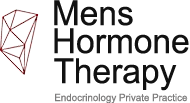Doctors specialized in HRT therapy
Through aging changes in body composition are taking place, consisting of an increase in body fat and an accompanying decrease in muscle mass. Numerous studies have consistently demonstrated a decrease in muscle mass, ranging from 20 to 30% with a parallel increase of body fat of 12 to 20% between the age of 20 to 80 years old.
The weakening of muscle mass starts from the fourth decade of life and strikingly accelerates from the seventh decade of life onwards. Interestingly, the decline in muscle mass principally refers to a decline in skeletal muscle mass (upper and lower limps), as the non-skeletal muscle mass remains stable during adult life. So it appears, that men lose around 20% of their arm and leg muscle mass between the age of 20 to 70 years.
Interestingly, by plotting these data and knowing from wasting and starvation patients that humans cannot sustain a loss of more than 40% of their muscle mass, it has been predicted that the maximum life span could not exceed 110 years of life.
The decrease of growth hormone and testosterone levels with aging may contribute to the deterioration of our physical performance with age.
Additionally, it appears that there are also qualitative changes in muscle mass, so a kilogram of muscle mass in a young man is different from that of an old man. Consequently, the non-contractile content of muscle (not active) in older adults is more than double when compared to young men.
Both growth hormone and testosterone in association with exercise are of paramount importance for the preservation of physical function. Exercise alone on the other hand seems to be an inadequate stimulus for physical function preservation when there is a marked growth hormone and testosterone deficiency, as seen in older men. Growth hormone and testosterone replacement therapy in men who are severe hormone deficient, by doctors specialized in HRT therapy, may indeed improve their physical function and quality of life.



Comments are closed.